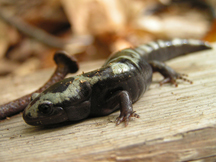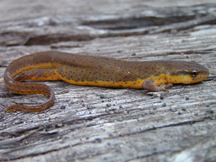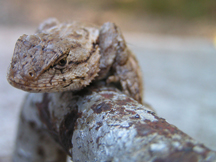
10-02-04
Trip Details
Start Time: 10:00 am
Weather: Cloudy, windy, and cool in the morning - partly cloudy, mid-sixties in the afternoon
Location: Johnson County, Illinois.
Herpers - Jeff LeClere, Mike Pingleton, Marty Whalen, Glen and Stacy Davis, Tracy Mitchell, Austin, Laura and Jim Scharosch
The next morning we woke up to a cloudy, windy and cold day. It looked like it was going to be really bad, and we weren't in the greatest spirits as we finished up breakfast and met up with the campers. We were introduced to Glen and Stacy who were joining our group today.
We got out to our first stop, a junk pile that looks like it gets worked by herpers about every thirty minutes. It was still cool out, but we started turning the large quantities of tin and boards that were strewn about in what seems to be very strategic locations. It was about 10:00 am when Mike found a good sized Black Racer (Coluber constrictor).
I was happy to see it, since it was cool out and I thought it would pose nicely for some pics. It did, unlike the one I had found in the spring which was only interested in seeing how many holes it could poke in my arm. I really like the black racer, having grown up finding the Yellow Belly Racers and Blue Racers in Iowa. This was the only find at this spot.
We moved on, and arrived at the bluff area. It was obvious from the temperatures that we were not going to really tear it up today, but we wouldn't suffer from a lack of effort. A little ways into the area, Austin found a juvenile Black Racer.
It was cool to see, as it maintained most of the juvenile pattern that the racers are born with and lose as they get older.
Jeff found two Western Smooth Earth Snakes (Virginia valeriae elegans) under the same rock not far from where the racer was found.
They were a little different in color from each other. I really like the small snakes, and I worked at trying to get some decent photos of them. The lighting again was less than optimal for my camera.
Stacy found a couple of nice colorful adult Northern Fence Lizards (Sceloporus undulatus hyacinthinus).
Again, it was cool enough to get them to sit still and pose for us, so we took photos for a while while the group moved on ahead.
A number of Cave Salamanders (Eurycea lucifuga) were found, although I didn't take any photos.
A sub-adult Black Racer was found too.
This one was larger than the last and didn't have as much of the juvenile patterning that the earlier one did.
We walked down a long road thru the woods, headed for a rocky hillside that Mike knew about. We turned some logs along the way, and found our first Marbled Salamanders (Ambystoma opacum) of the trip.
This one was found under a board near an old deer stand. We found two more, but I didn't take any more pictures.
We finally got to the hillside, and it was very snakey looking. I was sure we would find a milk snake or something here. After a while, someone called out that they had a Cottonmouth (Agkistrodon p. leucostoma).
It was laying out trying to bask on a rock, and it didn't move to get away. That was all we found there, and we walked back to the vehicles.
We loaded up, and took off for another spot where we had had good luck in the spring. It was about 3:00 pm when we arrived, and we knew this was going to be the best weather we were going to have.
As we worked our way down, Jeff found a Central Newt (Notophthalmus viridescens louisianensis).
The dry weather had forced this normally aquatic stage of the adult newt to become terrestrial. It didn't look like it was handling the transition very well.
I found another Fence Lizard, this one also chilly enough to pose for pictures.
They have a lot of personality, even when they are cold and don't want to be bothered.
We got to the pond area without seeing anything else, which was not a good sign at all. Once at the pond, I turned a small log and in the scramble of rock that went down the hillside I saw a snake. I went to grab it as it slid down the hill, touched it, then realized it was a fourteen inch long Cottonmouth.
I took my hand off it pretty quickly, then snagged it with my tongs and moved it to a better location for photography. Laura yelled out that we had found a "watermouth" which we all thought was pretty funny, and the name stuck for the rest of the day. I guess it is a combination of water moccasin and cottonmouth.
Soon someone else came over with a Copperbelly Watersnake (Nerodia erythrogaster flavigaster x neglecta), the only one of the trip.
It was about a foot long, and had a nicely colored belly and neck.
Jeff and Tracy moved ahead and found another Cottonmouth or two, but I didn't see them.
On the way back, Laura found a tiny Midwest Worm Snake (Carphophis amoenus helenae). They are one of my favorite snakes, and I was glad she found one. It couldn't have been more than two inches long. I put it under an acorn cap to get it to settle down for a photo attempt.
I didn't get any good pictures, it was so small.
Tracy found a juvenile Cottonmouth. It had the really nice coloration that babies always have. It didn't want to sit for photos long, and I didn't feel like messing with it much, but I did get one decent picture.
A little while later, as Tracy was climbing around a log pile, he managed to find another Cottonmouth. This one was bigger, maybe twenty inches long.
Tracy found it the hard way, putting his hand on it as he moved through the log pile. I don't know if he moved as quickly as he did when we found the skunk in Kansas this spring, but it was probably close.
That wrapped up the herping portion of the trip, as the temperature was already beginning to drop. We grabbed dinner and sacked out for the night. It got very cold Saturday night, and it had that "end of the herp season" feel in the air the next morning.
It was a good season this year, probably my best ever. Special thanks go out to Jeff LeClere, Mike Pingleton, Chad Whitney and everyone else that shared a herp trip or two with Matt and I this year.




























